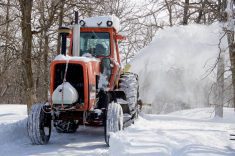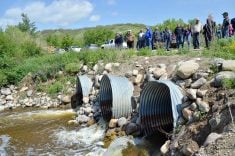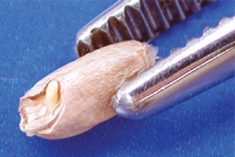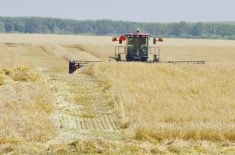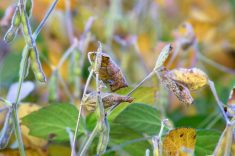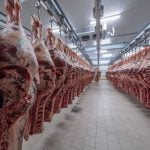Fall rye and winter wheat are at the soft dough stage with the most advanced fields ripening. Spring wheat ranges from flag to heading stage with fungicide application for fusarium head blight occurring. Spring wheat quality is rated mostly fair to good with about 10 per cent of the crop being reported as poor in the Northwest, Central, and Interlake regions.
Field peas have reached the R1-R2 stage, with some fungicide application occurring for mycosphaerella blight. Field peas overall crop condition continues to suffer in some regions with the extended wet conditions. Yellowing in saturated field areas continues to be evident with wilting plants and ample evidence of root rot was found in these fields. Fungicide application has also begun on canola that has reached the appropriate stage. Most crops are recovering from excess moisture and stress conditions have been noted in many regions mostly in low lying areas of fields.
Read Also
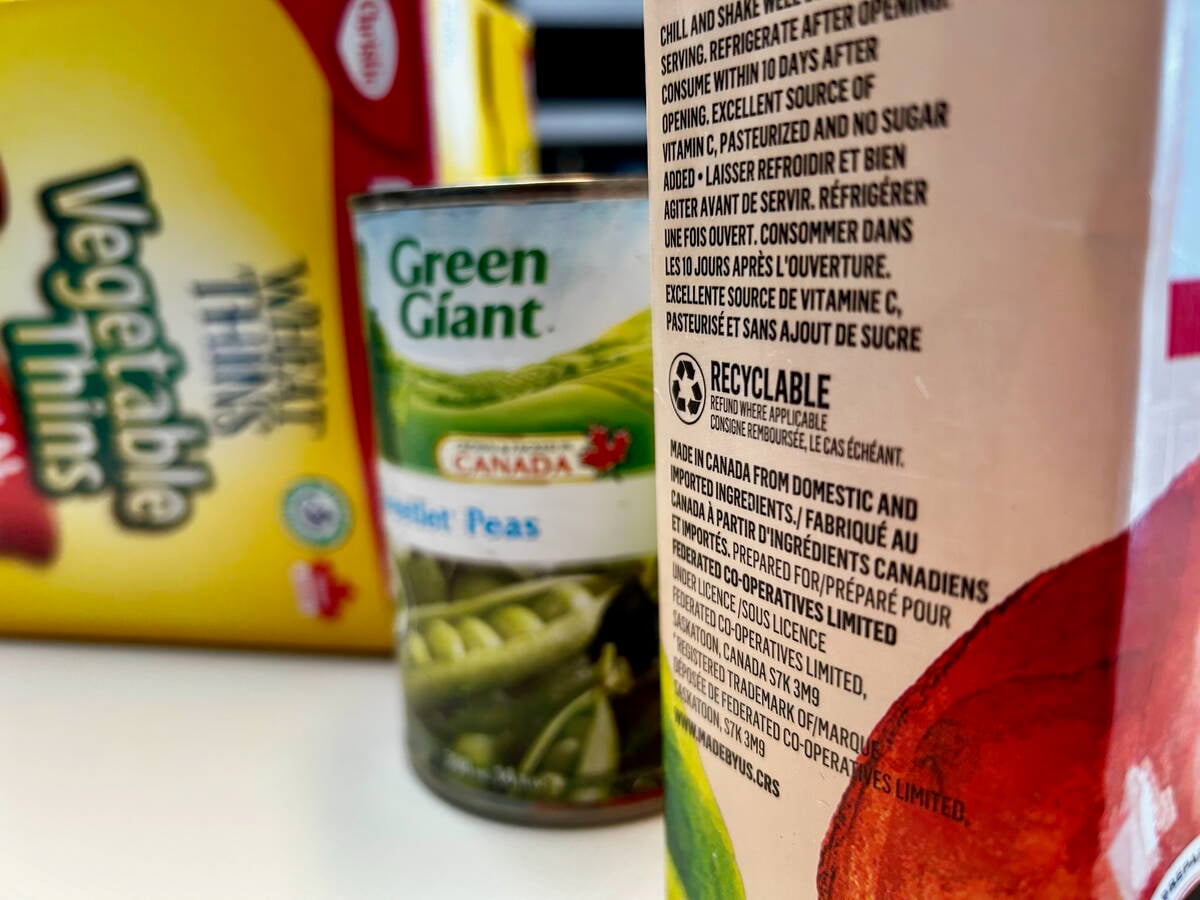
Unclear food labels hinder Canada’s ‘buy local’ surge
“Maple-washing” on Canadian food packaging makes label claims hard to keep straight and hurts both farmers and consumers trying to buy Canadian, economist says.

Cereals
Fall rye and winter wheat are at the soft dough stage with the most advanced fields ripening. Grain corn growth stage ranges from V6 to V8. Spring wheat is reported to be from flag to heading stage with fungicide application for fusarium head blight occurring. Spring wheat quality is rated mostly fair to good with about 10 per cent of the crop being reported as poor in the Northwest, Central, and Interlake regions.
Oilseeds
Canola growth stage ranges from the rosette to flowering stage. With fungicide application for sclerotinia occurring. Sunflowers are at the V8 to V12 growth stage with R1 stage being reported. Flax crops ranged from growth stage 5 to 7.
Pulses and Soybeans
Field peas have reached the R1-R2 stage, with some fungicide application occurring for mycosphaerella blight. Soybean growth stage ranges from second to fourth trifoliate with flowering being reported on earliest fields. Overall crop development is delayed with producers looking for warmer conditions to drive the crop forward. Iron deficiency chlorosis continues to show up in some fields. Dry beans are in third to fourth trifoliate stage.
Forages & Livestock
Forages
Rain events continue to make field access difficult and are not allowing for sufficient drying time of cut forages. Progress on first-cut harvest of hayfields is behind and producers are concerned about both the quantity and quality of harvested feed that will be available this winter. Producers have turned to bale wrapping to make silage bales as drying conditions have been difficult.
Putting up dry hay has been extremely challenging with the moisture received in most areas. Initial yields are reporting normal to above average yields if able to get dry hay up.
Grasses have headed out except for big blue stem and little blue stem grasses. The hay crop is exceptionally good, although there’s hope for a break in the rains during the cut.
Alfalfa fields are in mid to late bloom and forage with plentiful yield; forage quality is being compromised due to accessibility issues and will continue to decline as plants mature.
Livestock
Pastures are looking good, with lots of grass available for grazing. Bulls have been placed with cows. Areas in the Northwest region are reporting pastures and hayfields that are heavily saturated with ongoing rains.
Increased insect pressure and fly control, potential for foot rot, and pinkeye are the main animal health issues. Cattle on pasture are in good condition with the increased chance of disease due to insect pressures.
Dugouts and irrigation ponds are mostly recharged, with many rivers full, and some ditches with standing water in them.
Regional Comments
Southwest
There have been more showers in the Southwest region, with high humidity and rainfall ranging from 1 mm in Virden to 72 mm in Newdale area. Very localized storms have caused excess moisture conditions.
Many farmers are using airplanes to spray fungicides rather than working in fields. Small creeks are flowing, and some of the deeper low spots have standing water. Winter cereals and canola are looking great, and sunflowers appear decent. Early spring cereals are doing well, but later crops are behind in stage and need the heat forecasted for this week. Warm season crops like soybeans, dry beans, and corn are progressing slowly, but the warmer forecast will help them catch up in staging.
Corn has shown improvement this week and is mostly about 16 inches tall. Herbicide applications are complete, with fungicides to follow as cereals reach the appropriate stage. Warm and humid conditions are setting the stage for fusarium.
Canola is ranging from bolt to full flowering stage. Peas have flowers and are about 24 inches tall and flowering. Soybeans/dry beans are reaching the first flower at about 6 inches tall, sunflowers are at R1 stage, corn is at V9 stage, oats/spring wheat are at flag leaf to head- flowering stage, barley is booting to head emerged, winter wheat has completed anthesis, and fall rye is at milking stage.
Mycosphaerella and/or bacterial blight lesions are very prevalent in peas, and septoria or bacterial leaf spotting has been observed in oats, especially after recent rains.
Northwest
Several thunderstorms brought large amounts of precipitation during the week. Highest precipitation was at the Fork River station, recording 82 mm accumulated. Hail also accompanied these storms. Damage is unknown at this time. Overnight temperatures have stayed close to 10 C degrees and above this week. Highest daytime temperature was at The Pas station at 28 C degrees. Excess moisture is a concern and crops will need drying conditions.
Earliest field peas are now in R1 stage. For the most part fields are looking good, however there are fields affected by the excess moisture and doing poorly.
Spring wheat advanced into head emergence rapidly with recent heat. Most advanced fields have flowered. Fields affected by excess moisture are showing signs of stress and are yellowed and stunted. With recent moisture and humidity, fusarium head blight is a concern and many fields have been sprayed with fungicide.
Canola crops continue to be quite varied. Earliest seeded fields are flowering, and the remainder of the crop falls behind in the bolting and rosette stages. Flea beetle pressure has decreased slightly as the crops have advanced into stages that can tolerate feeding. Some poorer fields across the region are starting to bolt due to stress.
Soybean crops continue in second to fourth trifoliate stage and are mostly looking good. Recent heat has helped and advanced the crops.
Winter wheat and fall rye crops are in grain development stage and looking good in most areas not affected by excess moisture.
Central
The week brought several rainfall events, causing water to pool in low spots, and high humidity. The most rainfall was received in the southeast of the central region, at Windygates (80.7 mm). Austin, in the northwest part of the region received only 3.4 mm.
Crops in low lying areas are undergoing visible water stress, and there are dead spots in some fields. The moist conditions are contributing to iron deficiency chlorosis (IDC) in soybean. Cooler spring temperatures have delayed crop growth, and many crops are more advanced developmentally than they may at first appear given their height. Warm season crops including soybean, edible beans, and corn are the most affected.
The stage of each crop varies greatly at the local level across the region, with crops in the north at an earlier developmental stage than those in the Pembina Valley. Most cereals are heading out, with some still at the flag leaf stage. Fungicide applications are taking place where conditions allow, many by aircraft due to wet field conditions. Some lodging is present in barley and wheat fields.
Fall rye and winter wheat are at the soft dough stage with the most advanced fields ripening. Field peas are flowering and around 24 inches high. Soybeans are mostly between the third to the fourth trifoliate stage, with the earliest soybeans beginning to flower (R1). Iron deficiency chlorosis (IDC) is prevalent this year due to the moist conditions. The most advanced edible beans are approaching flowering. Canola is in early – mid flowering, with later fields from cabbaging to bolting stages. Flax is between stage 5 (stem extension) to stage 7 (first flower). Silage and grain corn growth has been slow this year due to the cool temperatures. Most of the crop is at V6 – V8, being more advanced in the south of the region.
Fungicide spraying is underway in cereals and canola, often taking place via aircraft due to difficulties accessing fields. Tan spot and stripe are present in cereal fields, and Septoria has been reported in oats. The humid conditions and dropping petals are creating ideal conditions for sclerotinia in canola. Mycosphaerella, bacterial blight and root rot are present in pea fields.
Eastern
Rainfall amounts across the region during the reporting period were again highly variable and ranged from 3 mm to 46 mm. Average rainfall in the region was 18 mm with the largest amount in Richer at 41 mm and Stead at 46 mm. Field access issues continue to challenge producer spraying progress, but some herbicide/fungicide application progress was made.
The standing water issues are subsiding in areas that did not receive significant rain. All crops continue to display yellowing with lower areas and field drains showing loss of plants. Producers remain concerned about weed growth stage and herbicide efficacy in later seeded fields. The wet conditions are causing issues with field access. Expect to see more fungicide aerial applications this week, especially with meeting the correct timing in canola for sclerotinia and the fusarium head blight in wheat. Ground application equipment will be used as well as field access improves.
Fall rye/winter wheat stands are in the soft dough stage. Rapid winter cereal crop development continued with crop conditions being good in areas that are not saturated. Early seeded spring cereals have moved into head emergence/flowering stage. Some lodging was noted in more advanced wheat fields.
Fungicide application on early seeded cereals has started and will continue this week as fields come into stage. Herbicide applications on later seeded cereals are finishing up as field conditions allow.
In corn, dependent on the field, second herbicide application progress is ongoing. Crop stage was generally more uniform and usually ranged from V6 to V7 in fields not overly saturated. While crop condition is rated as mostly good outside of saturated areas, corn development continues to lag. More reports have been received of cutworm damage/spraying on corn acres from the most eastern parts of the region.
Soybean growth stage ranges from second to fourth trifoliate with flowering being reported (R1). First pass herbicide applications are wrapping up. Soybean fields continue to show yellowing this week and is attributed to the effects of excess moisture, herbicide application and iron chlorosis.
Herbicide spraying continues on late seeded canola crop with growth stages at rosette/cabbaging. Early seeded canola is at 50 per cent flower with fungicide applications ongoing. With the wet conditions and humidity, there is an increased risk for sclerotina development in the crop. Most acres are expected to see a fungicide application to reduce the risk of disease.
Sunflowers continue to be in the vegetative growth stage, V8 to V12, with a lot of variation due to planting date and water stressed conditions.
Interlake
Rainfall continues to be variable with scattered thundershowers and localized heavy downpours. Areas receiving the highest amounts of 30 to 56 mm include Woodlands, Teulon, Selkirk, Fisherton and Riverton. Scattered showers for much of the region were in the 10 to 30 mm range. Fields are wet with water ponding in most fields in the Teulon area. Although improvement is evident, much of the region continues to record higher than normal amounts of precipitation.
Rapid crop advancement is evident with temperatures in the high 20 C range and high humidity. However, soybean and canola growth has been slower due to wet conditions and sub-optimal heat so far this growing season. Field conditions continue to be variable.
Most of the spring wheat is at four leaf to stem elongation. Early seeded spring wheat is at the flag to full head emergence stage, with cereal fungicide spraying expected to start mid-week. Oats and barley are at similar growth stages. Winter wheat and fall rye growth stages have advanced to full head emergence and are at the milk to soft stage.
Peas are looking good and advanced at eight to ten node stage, with fungicide application underway in some areas in the south Interlake. Reports of bacteria lesions in some pea fields.
Early seeded canola is at bolting to flowering stages. Fungicide spraying has started on canola.
Soybeans in general look good at second to fourth trifoliate stage. Soybean development continues to be delayed with cool wet conditions. Iron deficiency chlorosis (IDC) is still noticeable in soybean fields. Fields continue to show yellowing leaves as evidence of excess moisture.
Sunflowers have emerged nicely and are in good condition at the V8 to V12 stage. Flax stands look great with growth stages ranging from stage 4 to Stage 5.



